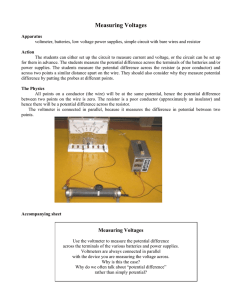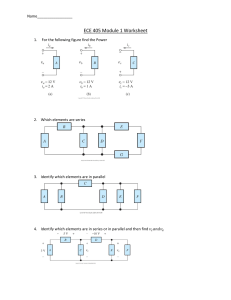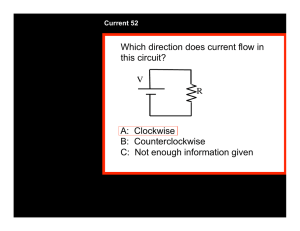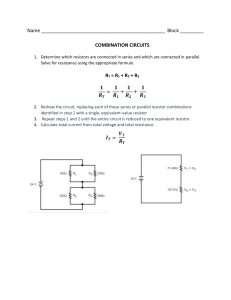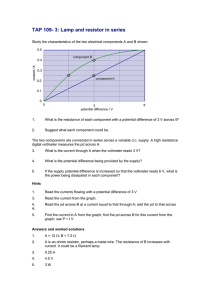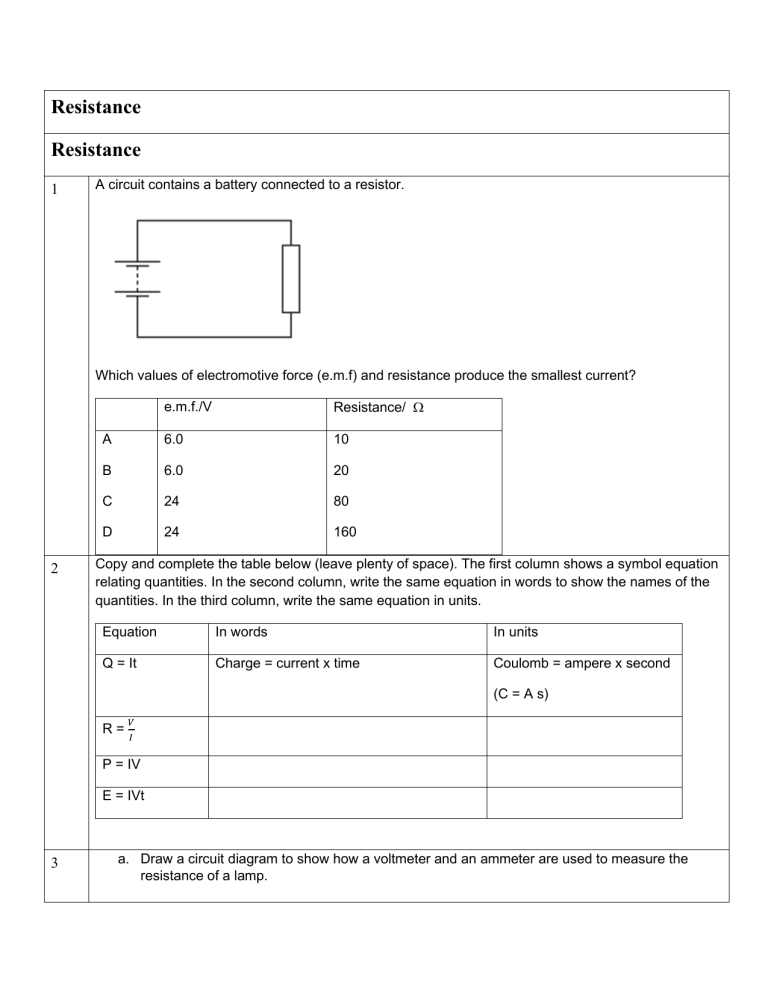
Resistance Resistance 1 A circuit contains a battery connected to a resistor. Which values of electromotive force (e.m.f) and resistance produce the smallest current? 2 e.m.f./V Resistance/ A 6.0 10 B 6.0 20 C 24 80 D 24 160 Copy and complete the table below (leave plenty of space). The first column shows a symbol equation relating quantities. In the second column, write the same equation in words to show the names of the quantities. In the third column, write the same equation in units. Equation In words In units Q = It Charge = current x time Coulomb = ampere x second (C = A s) R= 𝑉 𝐼 P = IV E = IVt 3 a. Draw a circuit diagram to show how a voltmeter and an ammeter are used to measure the resistance of a lamp. b. Write the equation relating voltage, current and resistance that you would use to calculate the resistance of the lamp. 4 a. What is the resistance of a lamp if a current of 2.0 A flows through it when it is connected to a 12 V supply? b. If the p.d. across the lamp is increased, will the current flowing increase or decrease? 5 When a 4 resistor is connected across the terminals of a 12 V battery, the number of coulombs passing through the resistor per second is a. b. c. d. 6 0.3 3 4 12 Calculate the following a. The potential difference required to produce a current of 2 A in a 12 resistor. b. The potential difference required to produce a current of 0.1 A in a 200 resistor. c. The current produced when a potential difference of 12 V is applied to a 100 resistor. d. The current produced when a potential difference of 230 V is applied to a 10 resistor. e. The resistance of a wire that under a potential difference of 6 V carries a current of 0.1 A. f. 7 The resistance of a heater, which under a potential difference of 230 V carries a current of 10 A. This is a circuit to show how a cell can be connected to a switch and a lamp, so that the lamp lights up when the switch is closed. a. Show the flow of electrons and flow of current b. Name the device you would use to measure the e.m.f of the cell. c. What unit is e.m.f. measured in? Ohm’s law and Effects of length and cross-sectional area 8 Three pieces of resistance wire X, Y and Z are made of the same metal. The diagram shows the lengths and the diameters of the wires. What is the order of the wires when they are placed in order of increasing resistance, least resistance first? a. b. c. d. 9 A piece of wire has a resistance of 8.0 . The length of the wire is doubled and the diameter of the wire is halved. What is the new resistance of the wire? a. b. c. d. 10 Y→X→Z Y→Z→X Z→X→Y Z→Y→X 2.0 4.0 8.0 64 a. Explain why the resistance of a conductor is proportional to length. b. Explain why the resistance of a conductor is inversely proportional to cross-sectional area. c. i. The length of a resistor A is x. Resistor B is made of the same material and is of the same thickness, but its length is 3x. the resistance of A is R. what is the resistance of B? ii. The area of cross-section of a resistor A is x. Resistor B is made of the same material, but its area of cross-section is 3x. The resistance of A is R. What is the resistance of B? 11 A student cuts two pieces of wire, one long and one short, from a reel. a. Which piece of wire will have the greater resistance? b. Draw a circuit diagram to show how you would check your answer by measuring the resistance of the two pieces of wire. 12 A 1.0 m length of wire is found to have a resistance of 40 . a. What would be the resistance of a piece of the same wire of length 2.0 m. b. What would be the resistance of a 2.0 m wire with half the cross-sectional area, made of the same material? 13 An electric heater, sold in the electrical store, has a current of 8 A when it is working normally. The cable fitted to the heater has a maximum safe current of 12 A. a. Which of the following fuses would be most suitable to use in the plug fitted to the cable of the heater? i. 5A ii. 10 A iii. 13 A iv. 20 A b. The cable for connecting an electric cooker is much thicker than the cable on a table lamp. i. Why do cookers need a much thicker cable? ii. What would happen if a thin cable were used for wiring a cooker to the supply? 14 The graph in Figure 1 illustrates how the p.d. across the ends of a conductor is related to the current in it. a. what law may be deduced from the graph? b. what is the resistance of the conductor? 15 The graph shows how the resistance of the filament of a lamp changes as the current through the lamp changes. a. Describe how the resistance of the lamp changes. b. For a current of 0.070 A, find: i. The resistance of the lamp ii. The potential difference across the lamp iii. The power being dissipated by the lamp.

